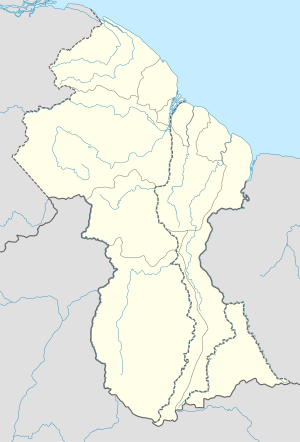Peoples Temple
The Peoples Temple of the Disciples of Christ,[1] commonly shortened to Peoples Temple, was an American new religious movement which existed between 1955 and 1978. Originally founded in Indianapolis, Indiana by Reverend Jim Jones, the Peoples Temple spread a message that combined elements of Christianity with communist and socialist ideology, with an emphasis on racial equality. After Jones moved the group to California in the 1960s and established several locations throughout the state, including its headquarters in San Francisco, the Temple forged ties with many left-wing political figures and boasted 20,000 members (though 3,000–5,000 are more likely).
| Peoples Temple | |
|---|---|
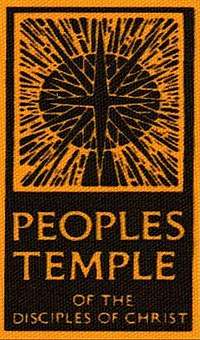 | |
| Classification | Cult Utopian/social change cult |
| Orientation | Eclectic Pentecostal with Christian socialist and communist elements / Theosophical / New Thought |
| Polity | Semi-congregationalist |
| Leader | James Warren "Jim" Jones (1955–1978) |
| Region | Defunct from 1978, formerly present in: United States |
| Founder | Jim Jones |
| Origin | 1955 Indianapolis, Indiana, U.S. |
| Defunct | December 4, 1978 |
| Congregations | 7 in California (prior moving to Guyana) |
| Members | 3,000–5,000 (over 20,000 claimed but not substantiated) |
| Ministers | James Warren "Jim" Jones |

The Temple is best known for the events of November 18, 1978, in Guyana, when 909 people died in a mass murder at its remote settlement, named "Jonestown", as well as the murders of U.S. Congressman Leo Ryan and members of his visiting delegation at the nearby Port Kaituma airstrip. The incident at Jonestown resulted in the greatest single loss of American civilian life in a deliberate act prior to the September 11 terrorist attacks. Because of the killings in Guyana, the Temple is regarded by scholars and by popular view as a destructive cult.
Before California
Indiana formation

Before forming a church, Jim Jones had become enamored of communism and was frustrated by the harassment communists received in the U.S. during the Red Scare.[2] This, among other things, provided a clerical inspiration for Jones; as he himself described in a biographical recording:[2][3]
I decided, how can I demonstrate my Marxism? The thought was, infiltrate the church. So I consciously made a decision to look into that prospect.
Although Jones feared a backlash for being a communist, he was surprised when a Methodist superintendent (whom he had not met through the American Communist Party) helped him into the church, despite his knowledge that Jones was a communist.[4] In 1952, Jones became a student pastor in Sommerset Southside Methodist Church in Indianapolis, Indiana, but left that church because it barred him from integrating African-Americans into his congregation.[3] In 1954, Jones began his own church in a rented space in Indianapolis, at first naming it the Community Unity Church.[3]
Jones had previously observed a faith healing service at the Seventh Day Baptist Church, and concluded that such healings could attract people, and generate income, helping to accomplish his social goals.[3] Jones and Temple's members knowingly faked healings because they found that the increased faith generated financial resources to help the poor and finance the church.[3] These "healings" involved chicken livers and other animal tissue, claimed by Jones (and confederate Temple members) to be cancerous tissues removed from the body.[5]
In 1956, Jones bought his first church building, located in a racially mixed Indianapolis neighborhood. He first named this church Wings of Deliverance,[6] and later that year renamed it the Peoples Temple Full Gospel Church, the first time he used the phrase "Peoples Temple."[3] Jones' healings and purported clairvoyant revelations attracted spiritualists.[6]
Indianapolis expansion
In order to increase publicity, the Peoples Temple organized large religious "conventions" with other Pentecostal pastors, with Jones continuing to disguise the fact that he was using religion to further his political ideology.[6] Those conventions drew as many as 11,000 attendees,[6] as Jones and the other preachers conducted "healings" and impressed attendees by revealing private information—usually addresses, phone numbers, or Social Security numbers, which private detectives could easily discover beforehand.[6] Jones and Temple members also drove through various cities in Indiana and Ohio on recruiting and fundraising efforts.[7]
The Temple stressed egalitarian ideals, asking members to attend in casual clothes so poor members would not feel out of place, and providing shelter for the needy.[8] While the Temple had increased its African-American membership from 15% to nearly 50%, in order to attempt further gains the Temple hired African-American preacher Archie Ijames (who had earlier given up organized religion).[6] Pastor Ijames was one of the first to commit to Jones' socialist collective program.[8] In 1959, the church joined the Christian Church (Disciples of Christ), and was renamed the Peoples Temple Christian Church Full Gospel.[3] This affiliation was a successful attempt to both raise the dwindling membership and restore the reputation of the organization.
In February 1960, the Temple opened a soup kitchen for the poor, and expanded their social services to include rent assistance, job placement services, free canned goods, clothing, and coal for winter heating.[8] Jones and his wife Marceline helped to increase the Temple's soup kitchen service to an average of about 2,800 meals per month.[8] The Temple's public profile was further elevated when Jones was appointed to the Indianapolis Human Rights Commission. He engaged in public attempts to integrate businesses and was the subject of much local media coverage.[9]
Changes and "religious communalism"
Jones had read extensively about Father Divine, the founder of the International Peace Mission movement.[10] Jones and members of the Temple visited Divine several times, while Jones studied his writings and tape recordings of his sermons.[11] The Temple printed Divine's texts for its members and began to preach that members should abstain from sex and only adopt children.[11]
In 1959, Jones tested the new fiery rhetorical style that Divine had used in a sermon.[12] His speech captivated members with lulls and crescendos, as Jones challenged individual members in front of the group.[12] The speech also marked the beginning of the Temple's underlying "us versus them" message.[12] Jones carefully wove in that the Temple's home for senior citizens was established on the basis "From each according to his ability, to each according to his need", quoting Karl Marx's Critique of the Gotha Program.[13] He did so knowing that his Christian audience would recognize the similarities with text from the Acts of the Apostles (4:34–35) which stated: "distribution was made to each as any had need."[13] Jones would repeatedly cite that passage to paint Jesus as a communist, while at the same time attacking much of the text of the Bible.[13]
The Temple began tightening control over its organization,[8] asking more of its members than did other churches.[8] It required that members spend Thanksgiving and Christmas with its Temple "family" rather than with blood relatives,[8] the beginning of a process to wean members from outside contact and redirect their lives toward a total commitment to the Temple and its goals.[8] Jones began to offer a deal towards a socialist collective, which he referred to as "religious communalism", in which members would donate their material possessions to the Temple in exchange for the Temple meeting all those members' needs.[8] Pastor Ijames was one of the first to commit.[8]
The Temple had little luck converting most Midwesterners to communist ideals, even when disguised as religion.[14] Admiring the 1959 Cuban Revolution, Jones traveled to the island nation in 1960 in an unsuccessful attempt to persuade poor black Cubans to move to his congregation in Indiana.[14] The Temple's religious message transitioned during this period, to one treading between atheism and the subtle notion that Jones was a Christ-like figure.[15] While Temple aides complained privately, Jones said that the new message was needed to foster members' dedication to the Temple's larger goals.[15] He maintained such implications until the mid-to-late 1970s.[15]
In 1961, Jones claimed he had had a vision in which Indianapolis and Chicago were destroyed in a nuclear attack,[16][16] convincing aides that the Temple needed to look for a new location. A 1962 Esquire magazine article listed the nine safest places to be in a nuclear war, with Belo Horizonte, Brazil, topping the list because of its location and atmospheric conditions.[17] Jones traveled through Brazil from 1962 through early 1963.[18] He requested money from the Temple while in Rio de Janeiro, but the Temple lacked adequate funds for such a request because of shrinking finances in Jones' absence.[18] Jones sent a preacher that had become a follower in Brazil back to Indiana to help stabilize the Temple.[19] Jones returned to Indiana in 1963.[3]
In California
Move to California
While he had always spoken of the social gospel's virtues, Jones did not reveal that his gospel was actually communism until the late 1960s.[3] By then, he was openly revealing in Temple sermons his "Apostolic Socialism" concept.[3][20] The concept often loosely mixed tenets of socialism.[note 1] During this period, Jones preached to new members that the Holy Spirit was within them, but that Jones's healing power demonstrated that he was a special manifestation of "Christ the Revolution."[3] He also preached that the U.S. was the Antichrist and capitalism "the Antichrist system."[3]
Jones preached of an imminent nuclear holocaust, after which the surviving elect would create a new socialist Eden on earth.[3] In 1965, he predicted this would occur on July 15, 1967.[3] Accordingly, Jones preached that the Temple must move to Redwood Valley, California.[3] In July 1965, he led approximately 140 members, half of whom were black, to Redwood Valley, and officially re-established his church there.[7][21] The addition of deputy district attorney Timothy Stoen greatly increased the Temple's credibility in the area, quickly increasing membership.[21]
Jones began deriding traditional Christianity as "fly away religion," and rejected the Bible as white men's justification to dominate women and enslave people of color.[3] He authored a booklet he would distribute in the Temple, "The Letter Killeth",[22] pointing out what he felt were the contradictions, absurdities, and atrocities in the Bible, but also stating that the Bible contained great truths. Jones preached that the "Divine Principle" equated with love, and love equated with socialism.[3] He said the Bible contained beliefs about only a "Sky God" or "Buzzard God," who was no God at all.[3]
Urban expansion

Because of limited expansion in the Redwood Valley-Ukiah area, it eventually seemed necessary to move the church's seat of power to an urban area.[23] In 1970, the Temple began holding services in San Francisco and Los Angeles.[24] It established permanent facilities in those cities in 1971 and 1972, respectively.[23] In San Francisco, the Temple occupied a former Scottish Rite temple at 1859 Geary Boulevard; in Los Angeles, the Temple occupied the former building of the First Church of Christ, Scientist at 1366 S. Alvarado Street.
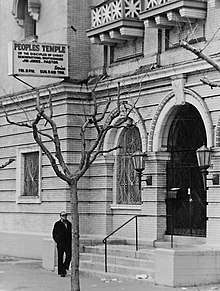
By 1972, the Temple called Redwood Valley the "mother church" of a "statewide political movement".[23] From the start, the Los Angeles facility's primary purposes were to recruit members and to serve as a waystation for the Temple's weekly bus trips across California.[23] The Temple set up permanent staff in Los Angeles and arranged bus trips to Los Angeles every other week.[23] The substantial attendance and collections in Los Angeles helped support the Temple's inflated membership claims.[23] The Los Angeles facility was larger than San Francisco's.[23] Its central location at the corner of Alvarado and Hoover Streets permitted easy geographic access for a large Black membership from Watts and Compton.[23]
Recruiting drives in Los Angeles and San Francisco helped increase membership in the Temple from a few hundred to nearly 3,000 by the mid-70s.[25] Later, when the Temple's headquarters shifted from Redwood Valley to San Francisco, the Temple convinced many Los Angeles members to move north to its new headquarters.[23]
Organizational structure
Although some descriptions of the Peoples Temple emphasize Jones's autocratic control over its operations, in reality, the Temple possessed a complex leadership structure with decision-making power unevenly dispersed among its members. Within that structure, Temple members were unwittingly and gradually subjected to sophisticated mind control and behavior modification techniques borrowed from post-revolutionary China and North Korea.[26] The Temple tightly defined psychological boundaries that "enemies", such as "traitors" to the Temple, crossed at their own peril.[26] While the secrecy and caution Jones demanded in recruiting led to decreased overall membership, they also helped him foster hero-worship of himself as the "ultimate socialist".[26]
In the 1970s, the Temple established a more formal hierarchy for its socialistic model.[27] At the top were the Temple's staff, a select group of predominantly college-educated white women that undertook the Temple's most sensitive missions.[27] They necessarily acclimated themselves to an "ends justify the means" philosophy.[27] The earliest member was Sandy Bradshaw, a socialist from Syracuse, New York.[27] Others included Carolyn Layton, a communist since the age of 15 who had a child with Jones; Sharon Amos, who worked for the social services department; Patty Cartmell, Jones's secretary; and Teri Buford, a Navy brat turned pacifist.[27] The group was often scorned as elitist within the egalitarian Temple organization and viewed as secret police.[27]
The Temple's Planning Commission was its governing board.[28][29] Membership quickly ballooned from 50 to over 100.[28][29] During the week, members convened for meetings in various Redwood Valley locations, sometimes until dawn.[28] The Planning Commission was responsible for the Temple's day-to-day operations, including key decision-making, financial and legal planning, and oversight.[30] The Commission sat over various other committees, such as the Diversions Committee, which carried out tasks such as writing huge numbers of letters to politicians from fictional people mailed from various locations around the U.S.,[31] and the Mertles Committee, which undertook activities against defectors Al and Jeannie Mills.[32]
A group of rank-and-file members, whom outsiders called the "troops", consisted of working-class members who were 70–80% black. They set up chairs for meetings, filled offering boxes, and did other tasks.[27] Many of them were attracted to the Temple's quasi-socialist approach both because of the Temple's political education offers and because the Temple's highly passionate congregations still maintained the familiar forms of evangelical prayers and black gospels.[27] Jones also surrounded himself with several dozen mostly white, privileged members in their twenties and thirties who had skills in law, accounting, nursing, teaching, music, and administration.[27] This latter group carried out public relations, financial duties, and more mundane chores while bringing in good salaries from well-paying outside jobs.[27]
Recruiting, faith healings, and fund raising
The Temple used ten to fifteen Greyhound-type bus cruisers to transport members up and down California freeways each week for recruitment and fundraising.[33] Jones always rode in bus number seven, which contained armed guards and a special section lined with protective metal plates.[33] He told members that the Temple would not bother scheduling a trip unless it could net $100,000, and the Temple's goal for annual net income from bus trips was $1 million.[33]
Beginning in the 1970s, the bus caravan also traveled across the U.S. quarterly, including to Washington, D.C.[33] In June 1973, Representative George Brown, Jr. entered a lengthy and laudatory description of the Temple into the Congressional Record.[33] The Washington Post ran an August 18, 1973, editorial-page item stating that the 660 Temple visitors were the "hands down winners of anybody's tourists of the year award" after spending an hour cleaning up the Capitol grounds.[33]
The Temple distributed pamphlets in cities along the route of these fundraising trips bragging of Jones's prowess at "spiritual healing" without mentioning the Temple's Marxist goals.[33] Stops included large cities such as Houston, Detroit, and Cleveland.[33] Temple members pretended to be locals and acted as shills in the various faked healings and "revelations".[33] Local viewers did not realize they were in the minority in the audience.[33] The weekly take from offerings and healing services was $15,000 to $25,000 in Los Angeles and $8,000 to $12,000 in San Francisco.[34] There were smaller collections from trips around the "mother church" in Redwood Valley.[34]
The Temple also set up Truth Enterprises, a direct mailing branch that sent out 30,000 to 50,000 mailers monthly to people who had attended Temple services or written to the Temple after listening to Temple radio programs.[34] Donations were mailed in from all over the continental U.S., Hawaii, South America, and Europe.[34] In addition to receiving donations, the Temple sold trinkets, such as pieces of Jones's robes, healing oil, Temple rings, key chains, and lockets.[34] In peak periods, mailer revenue grossed $300 to $400 daily.[34] This figure even surprised Jones.[34]
Although Jones had earlier asked Temple members to destroy photos of him because he did not want members worshiping him as Catholics "worshiped plaster statues", Jeannie and Al Mills (who would later defect) convinced Jones to sell anointed and blessed photos to raise money.[34] Jones worried that "they're gonna get me for mail fraud someday."[34] In 1973, the Temple also formed Brotherhood Records, a subsidiary record label that produced music from the Temple's "large interracial youth choir and orchestra".[35]
Size and scope
Despite exaggerated claims by the Temple of 20,000 or more members, one source claims its greatest actual registered membership was around 3,000.[36] However, 5,000 individual membership card photos were located in Temple records after its dissolution.[37] Regardless of its official membership, the Temple also regularly drew 3,000 people to its San Francisco services alone.[38] Of particular interest to politicians was the Temple's ability to produce 2,000 people for campaign work or attendance in San Francisco on only six hours' notice.[21]
By the mid-1970s, in addition to its locations in Redwood Valley, Los Angeles and San Francisco, the Temple had established satellite congregations in almost a dozen other California cities.[26] Jones mentioned locations in San Francisco, Los Angeles, Ukiah, Bakersfield, Fresno, and Sacramento.[39] The Temple also maintained a branch, college tuition program, and dormitory at Santa Rosa Junior College.[40][41]
At the same time, Jones and his church earned a reputation for aiding the cities' poorest citizens, especially racial minorities, drug addicts, and the homeless. The Temple made strong connections to the California state welfare system.[42] During the 1970s, the church owned and ran at least nine residential care homes for the elderly, six homes for foster children, and a state-licensed 40-acre (160,000 m2) ranch for developmentally disabled persons.[43] The Temple elite handled members' insurance claims and legal problems, effectively acting as a client-advocacy group. For these reasons, sociologist John Hall described the Temple as a "charismatic bureaucracy",[44] oriented toward Jones as a charismatic leader, but functioning as a bureaucratic social service organization.
Kinsolving series
In 1972, the San Francisco Examiner and Indianapolis Star ran the first four parts of a seven-part story on the Temple by Lester Kinsolving, its first public exposé.[45] Kinsolving reported on several aspects of church dealings, its claims of healings, and Jones's ritual of throwing Bibles down in church, yelling, "This black book has held down you people for 2,000 years. It has no power."[46] Temple members picketed the Examiner, harassed the paper's editor, and threatened both the Examiner and the Star with libel suits.[45] Both papers canceled the series after the fourth installment.[45] Shortly thereafter, Jones made grants to newspapers in California with the stated goal of supporting the First Amendment.[47]
Defections
Some defections occurred,[48] most especially in 1973, when eight young members – known as the "Gang of Eight" – defected together.[49] Because the Gang of Eight were aware of threats to potential defectors, they suspected Jones would send a search party to look for them.[49] Their fears proved correct: Jones employed multiple search parties, including one which scanned highways from a rented airplane.[50] The Gang of Eight drove three trucks loaded with firearms toward Canada, avoiding U.S. Highway 101.[49] Because they feared taking firearms over the U.S.-Canada border, the group traveled instead to the hills of Montana, where they wrote a long letter documenting their complaints.[50]
Former Temple member Jeannie Mills later wrote that Jones called thirty members to his home and forebodingly declared that, in light of the mass defection, "in order to keep our apostolic socialism, we should all kill ourselves and leave a note saying that because of harassment, a socialist group cannot exist at this time."[51] Jones became furious, waving a pistol at the Planning Commission and referring to the Gang of Eight as "Trotskyite defectors" and "Coca-Cola revolutionaries".[52] While the Temple did not execute the suicide plan Jones described, it did conduct fake suicide rituals in the years that followed.[51]
San Francisco Temple
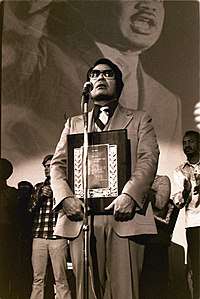
The move to San Francisco permitted Jones to be more open with his true political and theological leanings.[53] By spring 1976, Jones openly admitted even to outsiders that he was an atheist.[54] Despite the Temple's fear that the Internal Revenue Service (IRS) was investigating its religious tax exemption, Marceline admitted to The New York Times in 1977 that her husband, taking inspiration from Mao Zedong, was trying to achieve social change by mobilizing people through religion.[21] She admitted that, "Jim used religion to try to get some people out of the opiate of religion" and had slammed the Bible on the table yelling, "I've got to destroy this paper idol!"[21]
With the move into San Francisco, the Temple more strenuously emphasized that its members live communally.[55] It stressed physical discipline of children first, and then adults.[56] The San Francisco Temple also carefully vetted newcomers through an extensive observation process.[23]
The Temple distinguished itself from most new religious movements with its overtly political message.[57] It combined those genuine political sympathies with the perception that it could help turn out large numbers of votes to gain the support of a number of prominent politicians.[58] Jones made it known after he moved to San Francisco that he was interested in politics, and legal changes in the way San Francisco elections were held strengthened the power of neighborhood groups and civic organizations such as the Temple.[59][60]
After the Temple's voter mobilization efforts proved instrumental in George Moscone's run for mayor of San Francisco in 1975, he appointed Jones as Chairman of the San Francisco Housing Authority Commission.[61][62] Jones and the Temple received the support of California political figures such as Moscone, Jerry Brown, Mervyn Dymally, Willie Brown, Art Agnos, and Harvey Milk.[63] Willie Brown visited the Temple numerous times and spoke publicly in support of Jones, even after investigations and suspicions of cult activity.[64][65] Jones and Moscone met privately with then-running mate Walter Mondale in San Francisco days before the 1976 presidential election.[66] Jones also met First Lady Rosalynn Carter on multiple occasions, including a private dinner, and corresponded with her in letters.[67][68]
Jones used his position at the Housing Authority to lead the fight against the eviction of tenants from San Francisco's International Hotel.[69] The Temple further forged an alliance with San Francisco Sun Reporter publisher Carlton Goodlett and received frequent favorable mentions in that paper.[70] It also received frequent favorable coverage from San Francisco Chronicle columnist Herb Caen and other local newspaper and television reporters.[71]
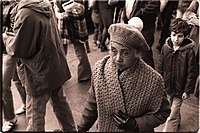
However, the Temple aroused police suspicion after Jones praised the Symbionese Liberation Army, a radical Bay Area group, and its leaders attended San Francisco Temple meetings.[72] Further suspicions were raised after the defection of Joyce Shaw and the mysterious death soon after of her husband, Bob Houston.[73] After tension rose between the Temple and the Nation of Islam in San Francisco, the group held a large "spiritual" jubilee at the Los Angeles Convention Center attended by thousands, including prominent political figures, to heal the rift.[74]
While the Temple forged media alliances, the move to San Francisco also opened the group to media scrutiny. When Jones and hundreds of Temple members fled to the Temple's Guyana settlement following media investigations, Mayor Moscone issued a press release stating that his office would not investigate the Temple.[59][75] During this time, Milk spoke at Temple political rallies[76] and wrote a letter to President Jimmy Carter after the investigations began, accused Timothy Stoen, who by that point had defected from the Temple and was attempting to extricate relatives from Guyana, of telling "bold-faced lies".[77][78][79]
Mass murder/suicide at Jonestown agricultural commune
In 1974, the Peoples Temple signed a lease to rent land in Guyana.[80] The community created on this property was called the Peoples Temple Agricultural Project, or, informally, "Jonestown". The settlement had as few as fifty residents in early 1977.[81]
Jones saw Jonestown as both a "socialist paradise" and a "sanctuary" from media scrutiny that had started with the Kinsolving articles.[82] Former Temple member Tim Carter said the Temple moved to Jonestown because "in '74, what we saw in the United States was creeping fascism."[83] Carter explained, "It was apparent that corporations, or the multinationals, were getting much larger, their influence was growing within the government, and the United States is a racist place."[83] He said the Temple concluded that Guyana was "a place in a black country where our black members could live in peace", "it was a socialist government" and it was "the only English-speaking country in South America."[83]
Increasing media scrutiny based on allegations by former members placed further pressure on Jones, especially after a 1977 article by Marshall Kilduff in New West magazine.[24] Just before publication of the New West piece, editor Rosalie Wright telephoned Jones to read him the article.[84] Wright explained that she was only doing so before publication because of "all the support letters we received on your behalf, from the Governor of California [Jerry Brown]" and others.[85] While still on the phone listening to the allegations contained in the article, Jones wrote a note to Temple members in the room with him that said, "We leave tonight. Notify Georgetown (Guyana)."[85] After Jones left for Guyana, he encouraged Temple members to follow him there. The population grew to over 900 people by late 1978.[81][86] Those who moved there were promised a tropical paradise free from the supposed wickedness of the outside world.[87]
On November 17, 1978, Representative Leo Ryan, who was investigating claims of abuse within the Temple, visited Jonestown.[88] During his visit, a number of Temple members expressed a desire to leave with him,[89] and, on November 18, they accompanied Ryan to the local airstrip at Port Kaituma.[90] There they were intercepted by self-styled Temple security guards who opened fire on the group, killing Ryan, three journalists, and one of the defectors.[91] A few seconds of gunfire from the incident were captured on video by NBC cameraman Bob Brown, one of the journalists killed in the attack.[91]
That evening, in Jonestown, Jones ordered his congregation to drink a concoction of cyanide-laced, grape-flavored Flavor Aid.[92][93]
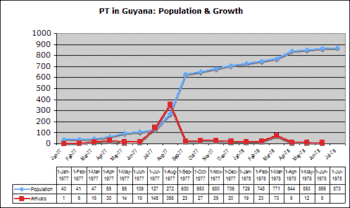 Jonestown arrivals and population
Jonestown arrivals and population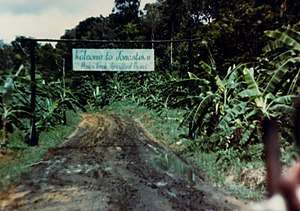 Entrance to Jonestown
Entrance to Jonestown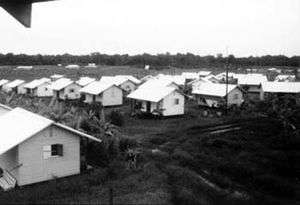 Housing in Jonestown
Housing in Jonestown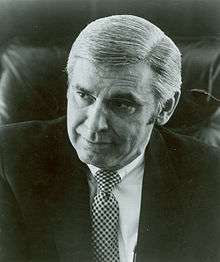 Congressman Leo Ryan
Congressman Leo Ryan
Aftermath
In all, 918 people died, including 276 children.[94] It was the greatest single loss of American civilian life in a deliberate act until the events of September 11, 2001.[95][96][97] This includes four that died at the Temple headquarters that night in the Guyanese capital of Georgetown.[98]
The Temple's San Francisco headquarters came under siege by national media and relatives of Jonestown victims.[99] The mass killing became one of the best-known events in U.S. history as measured by the Gallup poll and appeared on the cover of several newspapers and magazines, including Time, for months afterward.[100]
In addition, according to various press reports,[101][102] after the Jonestown suicides, surviving Temple members in the U.S. announced their fears of being targeted by a "hit squad" of Jonestown survivors. Similarly, in 1979, the Associated Press reported a U.S. Congressional aide's claim that there were "120 white, brainwashed assassins out from Jonestown awaiting the trigger word to pick up their hit."[103]
Temple insider Michael Prokes, who had been ordered to deliver a suitcase containing Temple funds to be transferred to the Communist Party of the Soviet Union,[104][105] committed suicide in March 1979, four months after the Jonestown incident. In the days leading up to his death, Prokes sent notes to several people, together with a thirty-page statement he had written about the Temple. Caen reprinted one copy in his Chronicle column.[106] Prokes then arranged for a press conference in a Modesto, California motel room, during which he read a statement to the eight reporters who attended. He then excused himself, entered a restroom, and fatally shot himself in the head.[106]
Before the tragedy, Temple member Paula Adams engaged in a romantic relationship with Guyana's Ambassador to the United States, Laurence "Bonny" Mann.[107] Adams later married Mann.[108] On October 24, 1983, Mann fatally shot both Adams and the couple's child, and then fatally shot himself.[108] Defecting member Harold Cordell lost twenty family members the evening of the poisonings.[109] The Bogues family, which had also defected, lost their daughter Marilee (age 18), while defector Vernon Gosney lost his son Mark (age 5).[110]
The mass suicide of the Peoples Temple has helped embed in the public mind the idea that all new religious movements are destructive. Bryan R. Wilson argues against that view by pointing out that only four other such events have occurred in similar religious groups: the Branch Davidians, the Solar Temple, Aum Shinrikyo and Heaven's Gate.[111]
Bankruptcy and dissolution
At the end of 1978, the Temple declared bankruptcy, and its assets went into receivership.[112] In light of lawsuits, on December 4, 1978, Charles Garry, the corporation's attorney, petitioned to dissolve the Temple. The petition was granted in San Francisco Superior Court in January 1979.[113] A few Temple members remained in Guyana through May 1979 to wrap up the movement's affairs, then returned to the U.S.[112]
The Temple's buildings in Los Angeles, Indianapolis, and Redwood Valley are intact, and some are used by church congregations.[112] The Temple's facility in Los Angeles is presently occupied by a Spanish-speaking Seventh-day Adventist congregation.[114] The Temple's former San Francisco headquarters at 1859 Geary Boulevard was destroyed in the 1989 Loma Prieta earthquake; the site is now occupied by a Post Office branch.
Freedom of Information requests from multiple persons over the past three decades aimed at the release of this information have been unsuccessful.[115][116][117]
Notes
- The Temple openly preached to established members that "religion is an opiate to the people." (Jones, Jim. "Transcript of Recovered FBI tape Q 1053." Alternative Considerations of Jonestown and Peoples Temple. Jonestown Project: San Diego State University.) Accordingly, "those who remained drugged with the opiate of religion had to be brought to enlightenment – socialism." (Layton 1999, page 53). In that regard, Jones also openly stated that he "took the church and used the church to bring people to atheism." (Jones, Jim. "Transcript of Recovered FBI tape Q 757." Alternative Considerations of Jonestown and Peoples Temple. Jonestown Project: San Diego State University). Jones often mixed those concepts, such as preaching that, "If you're born in this church, this socialist revolution, you're not born in sin. If you're born in capitalist America, racist America, fascist America, then you're born with a big dildo in sin. But if you're born in socialism, you're not born in sin."(Jones, Jim. "Transcript of Recovered FBI tape Q 1053." Alternative Considerations of Jonestown and Peoples Temple. Jonestown Project: San Diego State University.) "Archived copy". Archived from the original on May 1, 2011. Retrieved April 27, 2008.CS1 maint: archived copy as title (link)
References
- http://jonestown.sdsu.edu/wp-content/uploads/2013/10/DissolutionPeoplesTemple.pdf?
- Jones, Jim. "Transcript of Recovered FBI tape Q 134." Alternative Considerations of Jonestown and Peoples Temple. Jonestown Project: San Diego State University.
- Wessinger, Catherine. How the Millennium Comes Violently: From Jonestown to Heaven's Gate. Seven Bridges Press, 2000. ISBN 978-1-889119-24-3.
- Horrock, Nicholas M., "Communist in 1950s", New York Times, December 17, 1978
- Layton 1999, p. 65–66.
- Reiterman 1982. p. 49–52.
- Reiterman 1982. p. 57.
- Reiterman 1982. p. 54–55.
- Reiterman 1982. p. 68–72.
- Reiterman 1982. p. 59.
- Reiterman 1982. p. 59 and 65.
- Reiterman 1982. p. 60.
- Reiterman 1982. p. 61.
- Reiterman 1982. p. 62.
- Reiterman 1982. p. 74.
- Reiterman 1982. p. 76.
- Reiterman 1982. p. 77.
- Reiterman 1982. p. 83.
- Reiterman 1982. p. 85.
- Jones, Jim. http://jonestown.sdsu.edu/?page_id=27309 "Transcript of Recovered FBI tape Q 1023."]] Alternative Considerations of Jonestown and Peoples Temple. Jonestown Project: San Diego State University. "Archived copy". Archived from the original on May 1, 2011. Retrieved April 27, 2008.CS1 maint: archived copy as title (link)
- Lindsay, Robert. "How Rev. Jim Jones Gained His Power Over Followers." New York Times. November 26, 1978.
- Jones, Jim. "The Letter Killeth." Original material reprint. Department of Religious Studies. San Diego State University. "Archived copy". Archived from the original on February 5, 2011. Retrieved February 24, 2008.CS1 maint: archived copy as title (link)
- Reiterman 1982. page 164.
- Kilduff, Marshall and Phil Tracy. "Inside Peoples Temple." New West Magazine. August 1, 1977 (hosted at Alternative Considerations of Jonestown and Peoples Temple. Jonestown Project: San Diego State University). "Archived copy". Archived from the original on December 17, 2010. Retrieved October 28, 2006.CS1 maint: archived copy as title (link)
- Reiterman 1982. p. 156.
- Reiterman 1982. p. 163–64.
- Reiterman 1982. p. 156–159.
- Reiterman 1982. p. 160–163.
- Lewis, Mike. "Jones disciple recovers from, recalls painful past." Seattle Post-Intelligencer. November 19, 2003. Archived February 2, 2013, at Archive.today
- Dickerson, Toby. "Peoples Temple (Jonestown)". Archived from the original on September 8, 2006.. The Religious Movements Homepage Project. University of Virginia. February 5, 2005.
- Layton 1999, p. 62.
- Hall 1987, p.178–184
- Reiterman 1982. p. 166–168.
- Reiterman 1982. p. 169–171.
- Kilduff, Marshall and Ron Javers. Suicide Cult: The Inside Story of the Peoples Temple Sect and the Massacre in Guyana. Bantam Books, New York, 1978. ISBN 978-0-553-12920-5. page 42.
- Hall, John R. "The Impact of Apostates on the Trajectory of Religious Movement: The Case of the Peoples Temple", in David G. Bromley (ed.) Falling from the Faith: Causes and Consequences of Religious Apostasy. Sage Publications, 1988. ISBN 978-0-8039-3188-6. page 234.
- 'The Opposition, The Returned, Crisis & White Nights', Jonestown Institute, San Diego State University, May 2008. "Archived copy". Archived from the original on May 1, 2011. Retrieved June 12, 2008.CS1 maint: archived copy as title (link)
- Hall, John R. (1987). Gone from the Promised Land: Jonestown in American Cultural History. New Brunswick, New Jersey: Transaction Publishers. ISBN 978-0-88738-124-9. page 166
- Jones, Jim, FBI Tape Q 683, Jonestown Institute, San Diego State University "Archived copy". Archived from the original on May 1, 2011. Retrieved June 17, 2008.CS1 maint: archived copy as title (link)
- Layton 1999, p. 53.
- Hall, John R. (1987). Gone from the Promised Land: Jonestown in American Cultural History. New Brunswick, New Jersey: Transaction Publishers. ISBN 978-0-88738-124-9. page 90-91
- Hall 1987, p. 81–82
- Hall 1987, p.82
- Hall 1987, p.95
- Reiterman 1982. p. 211–214.
- Kinsolving, Lester. "SEX, SOCIALISM, AND CHILD TORTURE WITH REV. JIM JONES." San Francisco Examiner. September 1972.
- Reiterman 1982. p. 302–304.
- Reiterman 1982. p. 225–227.
- Reiterman 1982. p. 224.
- Reiterman 1982. p. 225.
- Paranoia And Delusions, Time Magazine, December 11, 1978 Archived September 10, 2010, at the Wayback Machine
- Reiterman 1982. p. 226.
- Hall, John R. (1987). Gone from the Promised Land: Jonestown in American Cultural History. New Brunswick, New Jersey: Transaction Publishers. ISBN 978-0-88738-124-9. page 161
- Jones, Jim in conversation with John Maher. "Transcript of Recovered FBI tape Q 622." Alternative Considerations of Jonestown and Peoples Temple. Jonestown Project: San Diego State University. "Archived copy". Archived from the original on February 5, 2011. Retrieved February 13, 2011.CS1 maint: archived copy as title (link)
- Reiterman 1982. page 256.
- Reiterman 1982. page 259.
- Reiterman 1982. p. 280.
- Reiterman 1982. p. 266–267 & 280.
- Los Angeles Herald Examiner, "The Political Pull of Jim Jones", November 21, 1978
- Reiterman 1982. page 263.
- Kinsolving, Kathleen and Tom. "Madman in Our Midst: Jim Jones and the California Cover Up." Archived December 31, 2010, at the Wayback Machine 1998. Steven Alan Hassan's Freedom of Mind Center. Retrieved October 14, 2010.
- Jonestown: The Life and Death of Peoples Temple. PBS.org. Archived March 14, 2009, at the Wayback Machine
- Layton 1999, page 105.
- Dooley, Nancy and Tim Reiterman. "Jim Jones: Power Broker." San Francisco Examiner. August 7, 1977.
- Layton 1999, p. 105.
- Reiterman 1982. page 302.
- Reiterman 1982. page 304.
- Jim Jones, "Transcript of Recovered FBI tape Q 799." Alternative Considerations of Jonestown and Peoples Temple. Jonestown Project: San Diego State University. "Archived copy". Archived from the original on May 1, 2011. Retrieved April 27, 2008.CS1 maint: archived copy as title (link)
- Reiterman 1982. page 282–283.
- Reiterman 1982. page 265.
- Reiterman 1982. page 285, 306 and 587.
- Reiterman 1982. page 236.
- Reiterman 1982. page 299–300.
- Reiterman 1982. page 282.
- Moore, Rebecca. A Sympathetic History of Jonestown. Lewiston: E. Mellen Press. ISBN 978-0-88946-860-3. p. 143.
- "Another Day of Death." Time. December 11, 1978. Archived May 1, 2011, at the Wayback Machine
- Coleman, Loren, "The Copycat Effect", Simon & Schuster, 2004, page 68
- Fishwick, Marshall, "Great Awakenings: Popular Religion and Popular Culture", Routledge, 1994, page 73
- Milk, Harvey. Letter Addressed to President Jimmy Carter, Dated February 19, 1978. Archived April 29, 2011, at the Wayback Machine
- Reiterman 1982. page 240–41.
- Entry to Guyana, Alternatives Considerations of Jonestown & Peoples Temple, San Diego State University "Archived copy". Archived from the original on December 18, 2010. Retrieved September 20, 2008.CS1 maint: archived copy as title (link)
- Hall 1987, p.132
- Tim Carter. There was no choice in Jonestown that day... Archived April 26, 2007, at the Wayback Machine Oregon Public Broadcasting Radio interview. April 9, 2007. "Archived copy". Archived from the original on December 31, 2010. Retrieved February 8, 2016.CS1 maint: archived copy as title (link)
- Layton 1999, page 111–116.
- Layton 1999, page 113.
- Reiterman 1982. page 346.
- Hall 1987, p.133
- Reiterman 1982. p. 487.
- Reiterman 1982. p. 512.
- Reiterman 1982. p. 524.
- Reiterman 1982. p. 529–531.
- Hall 1987, p.282
- "Jonestown Audiotape Primary Project". Alternative Considerations of Jonestown and Peoples Temple. San Diego State University. "Archived copy". Retrieved November 10, 2011.
- "1978: Mass Suicide Leaves 900 Dead". BBC News. Retrieved October 3, 2011.
- Rapaport, Richard, Jonestown and City Hall slayings eerily linked in time and memory, San Francisco Chronicle, November 16, 2003 Archived April 29, 2011, at the Wayback Machine
- Nakao, Annie. "The ghastly Peoples Temple deaths shocked the world."San Francisco Chronicle. April 14, 2005. Archived April 29, 2011, at the Wayback Machine
- Knapp, Don. "Jonestown massacre + 20: Questions linger." CNN.com. November 18, 1998. Retrieved April 9, 2007. Archived March 20, 2007, at the Wayback Machine
- Reiterman 1982. page 544-5.
- Reiterman 1982. p. 573
- Hall, John R. Gone from the Promised Land: Jonestown in American Cultural History. 1989. ISBN 978-0-88738-801-9. p. 289.
- Spencer, Duncan, "Cult's Ukiah Community in Fear of Vengeful Death Squads", Washington Star-News, November 23, 1978
- "Police Seek Out Cult 'Hit Squads'", San Francisco Examiner, November 22, 1978
- Steel, Fiona. "Jonestown Massacre: A 'Reason' to Die". CrimeLibrary.com. Archived from the original on May 15, 2011. Retrieved May 22, 2007.
- Reiterman 1982. pp 561–580.
- "Letter to Feodor Timofeyev." Alternative Considerations of Jonestown and Peoples Temple. Jonestown Project: San Diego State University. "Archived copy" (PDF). Archived from the original (PDF) on May 1, 2011. Retrieved November 12, 2012.CS1 maint: archived copy as title (link)
- "Statement of Michael Prokes." Alternative Considerations of Jonestown and Peoples Temple. San Diego State University: Jonestown Project. Retrieved September 22, 2007. "Archived copy". Archived from the original on December 7, 2010. Retrieved November 12, 2012.CS1 maint: archived copy as title (link)
- Reiterman 1982. pages 274–5 & 418.
- Weingarten, Gene. "The Peekaboo Paradox." The Washington Post. January 22, 2006. Archived May 1, 2011, at the Wayback Machine
- The Congregation of Peoples Temple. PBS.org. Archived February 25, 2009, at the Wayback Machine
- Who Died at Jonestown? Ross Institute. Archived December 19, 2010, at the Wayback Machine
- "Why the Bruderhof is not a cult – by Bryan Wilson | Cult And Sect | Religion And Belief". Scribd. Retrieved July 7, 2017.
- "What happened to Peoples Temple after 18 November 1978?" Alternative Considerations of Jonestown and Peoples Temple. San Diego State University: Jonestown Project. 2007-03-08. "Archived copy". Archived from the original on February 5, 2011. Retrieved June 11, 2008.CS1 maint: archived copy as title (link)
- "The Court's Wrapping-Up of Peoples Temple Affairs – Alternative Considerations of Jonestown & Peoples Temple". jonestown.sdsu.edu. Retrieved June 16, 2017.
- Central Spanish Seventh-day Adventist Church. AdventistChurchConnect.org. Archived July 24, 2011, at the Wayback Machine
- McGehee, Fielding M. III. "Attempting to Document the Peoples Temple Story: The Existence and Disappearance of Government Records." Alternative Considerations of Jonestown and Peoples Temple. San Diego State University: Jonestown Project. Archived May 22, 2014, at the Wayback Machine
- Richardson, James. "Jonestown 25 Years Later: Why All The Secrecy?". Archived from the original on May 1, 2011. Retrieved August 25, 2008.
- Taylor, Michael; Lattin, Don (November 13, 1998). "Most Peoples Temple Documents Still Sealed". San Francisco Examiner. Archived from the original on April 29, 2011. Retrieved August 25, 2008.
Sources
- Hall, John R. (2004). Gone from the Promised Land: Jonestown in American Cultural History. New Brunswick, New Jersey: Transaction Publishers. ISBN 978-0-7658-0587-4.
- Layton, Deborah. Seductive Poison. Anchor, 1999. ISBN 978-0-385-48984-3.
- Reiterman, Tim and John Jacobs. Raven: The Untold Story of Rev. Jim Jones and His People. Dutton, 1982. ISBN 978-0-525-24136-2.
Further reading
- Klineman, George and Sherman Butler. The Cult That Died. G.P. Putnam's Sons, 1980. ISBN 978-0-399-12540-9.
- Naipaul, Shiva. Black and White. London, 1980. ISBN 978-0-241-10337-1.
External links
| Wikisource has original text related to this article: |
- San Diego State University: Extensive site with source documents, list of dead, pictures
- Audio Recording of Jonestown Suicide
- Transcription of Suicide Tape
- Isaacson, Barry. From Silver Lake to Suicide: One Family's Secret History of the Jonestown Massacre
- 605 Adults 304 Children, a 2019 short documentary filmed entirely by The Peoples Temple at Jonestown
